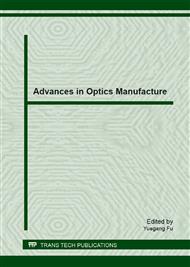p.238
p.244
p.248
p.252
p.256
p.262
p.271
p.276
p.281
Study of Polishing Technology for Aspheric Surface with High Efficiency
Abstract:
In recent years, for the compact system structure of aspheric lens, it has improved the image quality and excellent performance. More and more applications, in a variety of precision instruments, require the aspheric surface machining precision, fast, batch production. In order to further seek the effective method of aspheric surface processing, the aspheric NC machining technology is put forward. Therefore, this paper studies the aspheric surface in NC machining process of milling molding, polishing and polishing equipment related process parameters. Focusing on the milling process of various parameter settings, the resilient mold and small grinding head fixed combination method of polishing is introduced into the milling feedback compensation, solution of the elastic die polishing on the profile accuracy of destruction and processing to meet the requirements of the drawings of components: the contour measurement method on the profile accuracy of testing and surface shape accuracy of 0.5924um.
Info:
Periodical:
Pages:
256-261
Citation:
Online since:
May 2013
Authors:
Price:
Сopyright:
© 2013 Trans Tech Publications Ltd. All Rights Reserved
Share:
Citation:


